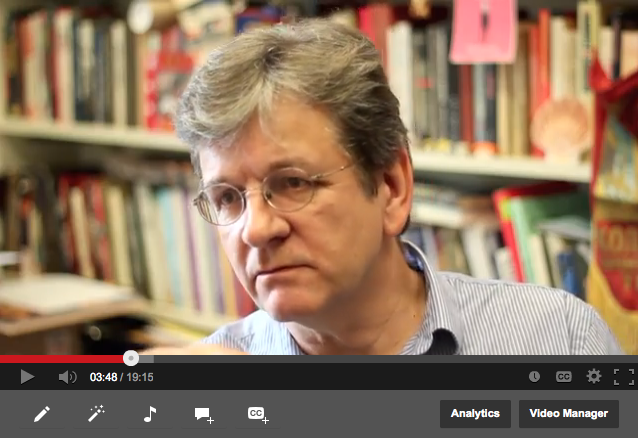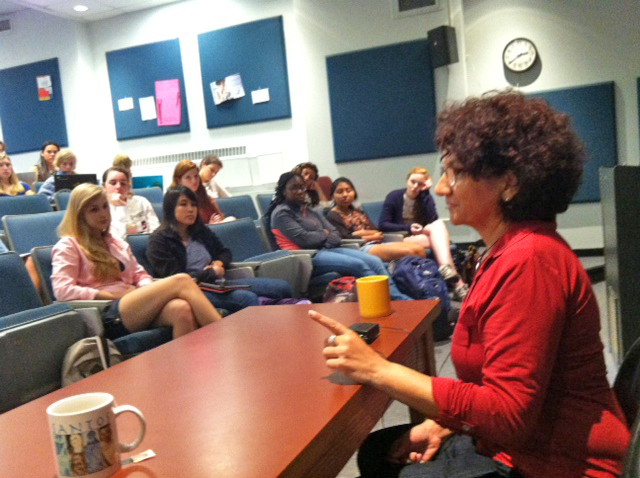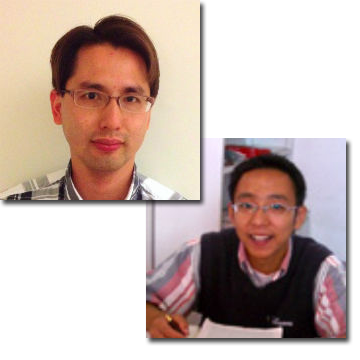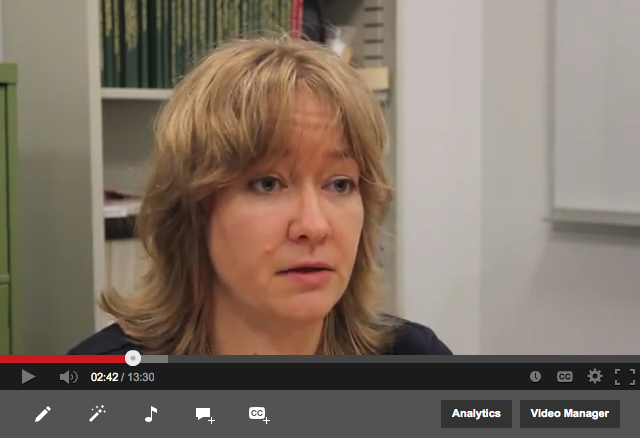This year, we are excited to have two new faculty in the Chinese program: Calvin Hui and Lunpeng Ma. Calvin Hui (PhD in Literature, Duke University, May 2013) is Assistant Professor of Chinese Studies. His research focuses on modern Chinese humanities (film, media, literature), critical theory, cultural studies, with an emphasis on Marxist theory, gender and sexuality studies, and post-colonial and ethnic studies. Lunpeng Ma is Visiting Assistant Professor of Chinese Studies. He defended his dissertation on post WWII Chinese cinema in the Department of Cultural Analysis and Theory at Stony Brook University in August 2013.
Interviewer: How do you feel teaching in the Chinese Program at William and Mary?
 Calvin: I really enjoy teaching at William and Mary. It’s such a wonderful liberal arts college where students can grow as scholars. I am impressed with W&M students – they are intelligent, diligent, curious, and passionate about intellectual work. It’s such a pleasure to work with them. I also feel lucky to be able to join the Modern Languages and Literatures department and the Chinese program. My colleagues are doing very exciting literary and cultural studies work. I respect them because they are good scholars and good teachers.
Calvin: I really enjoy teaching at William and Mary. It’s such a wonderful liberal arts college where students can grow as scholars. I am impressed with W&M students – they are intelligent, diligent, curious, and passionate about intellectual work. It’s such a pleasure to work with them. I also feel lucky to be able to join the Modern Languages and Literatures department and the Chinese program. My colleagues are doing very exciting literary and cultural studies work. I respect them because they are good scholars and good teachers.
 Lunpeng: I feel so thrilled to teach in such a dynamic, engaging liberal arts university. The class size is relatively small, the teaching atmosphere is easy-going and fun, and there are more conversations and debates between the professor and students. I am impressed by my students’ hard-working, thought-provoking questions, and avid interest in learning every aspect of China. Another fascinating facet is the cordiality of the faculty members, which makes me feel like a family.
Lunpeng: I feel so thrilled to teach in such a dynamic, engaging liberal arts university. The class size is relatively small, the teaching atmosphere is easy-going and fun, and there are more conversations and debates between the professor and students. I am impressed by my students’ hard-working, thought-provoking questions, and avid interest in learning every aspect of China. Another fascinating facet is the cordiality of the faculty members, which makes me feel like a family.
Interviewer: What are you teaching this semester? Tell me about your courses?
 Calvin: I am teaching two courses this fall semester. The first one is called “Fashion, Media, and Consumer Culture in (Post-)Socialist China,” a senior thesis seminar for Chinese majors. This course looks at fashion in relation to design, consumption, production, and disposal in the Chinese media landscape. By the end of the course, students have to produce a research paper and present their work in the Chinese major forum. I am already working with them on their final year projects. From the Chinese qipao to the first lady’s fashion, from romantic love and the first kiss to competitive dating shows, from the communist revolutionary to the migrant worker, we are looking at the radical transformations of China from the socialist to the post-socialist and neo-liberal eras. I hope you feel excited about their projects as much as I am! The second course is called “Introduction to Chinese Cultural Studies.” This course focuses on Maoism (political economy, class, and ideology), gender and sexuality (woman and queer cultures), and trans-nationalism (ethnicity and language). Like the way they sample Cantonese dim sum, students can have a taste of the most cutting-edge research in modern Chinese humanities.
Calvin: I am teaching two courses this fall semester. The first one is called “Fashion, Media, and Consumer Culture in (Post-)Socialist China,” a senior thesis seminar for Chinese majors. This course looks at fashion in relation to design, consumption, production, and disposal in the Chinese media landscape. By the end of the course, students have to produce a research paper and present their work in the Chinese major forum. I am already working with them on their final year projects. From the Chinese qipao to the first lady’s fashion, from romantic love and the first kiss to competitive dating shows, from the communist revolutionary to the migrant worker, we are looking at the radical transformations of China from the socialist to the post-socialist and neo-liberal eras. I hope you feel excited about their projects as much as I am! The second course is called “Introduction to Chinese Cultural Studies.” This course focuses on Maoism (political economy, class, and ideology), gender and sexuality (woman and queer cultures), and trans-nationalism (ethnicity and language). Like the way they sample Cantonese dim sum, students can have a taste of the most cutting-edge research in modern Chinese humanities.
 Lunpeng: I am currently teaching two classes, three sections. One is on Chinese Popular Culture, and the other Freshman Seminar (Country and City: Modern China in Transformation). The first class takes a generic approach to examine popular literature, Mandopop, mass films, and fashion. The seminar grapples with the drastic procedure in which China transforms from a rural country to a modern nation-state, a key issue that has been represented in various genres and, in particular, embodied in Shanghai’s urbanization.
Lunpeng: I am currently teaching two classes, three sections. One is on Chinese Popular Culture, and the other Freshman Seminar (Country and City: Modern China in Transformation). The first class takes a generic approach to examine popular literature, Mandopop, mass films, and fashion. The seminar grapples with the drastic procedure in which China transforms from a rural country to a modern nation-state, a key issue that has been represented in various genres and, in particular, embodied in Shanghai’s urbanization.
Interviewer: Tell me about your current project?
 Calvin: My book manuscript is called “The People’s Republic of Capitalism: The Making of the New Middle Class in Post-Socialist China.” This project attends to the cultural dimension of the emergence of the new middle class in China’ encounter with global capitalism during the past thirty/forty years. The first part investigates the constitution of the Chinese middle class subjectivity. The second part engages with fashion and cinema to examine the ideology of Chinese consumer culture. The third part looks at the repressed underside of consumption: the migrant worker and garbage.
Calvin: My book manuscript is called “The People’s Republic of Capitalism: The Making of the New Middle Class in Post-Socialist China.” This project attends to the cultural dimension of the emergence of the new middle class in China’ encounter with global capitalism during the past thirty/forty years. The first part investigates the constitution of the Chinese middle class subjectivity. The second part engages with fashion and cinema to examine the ideology of Chinese consumer culture. The third part looks at the repressed underside of consumption: the migrant worker and garbage.
 Lunpeng: My dissertation “Advantageously Adverse: Chinese Cinemas in Transition, 1945-1951,” explores “the second golden age” of Chinese cinema on which no English monograph yet exists. Departing from the misconception “Chinese-language” cinema, I employ a locale-specific and regionally-connected approach to examine Chinese cinemas in Shanghai, Hong Kong, Taiwan, and Manchuria. Departing from the scholarship on Shanghai cinema in the 30s, not only do I address the adversities facing postwar Chinese cinemas from a socio-historical perspective, I also reveal the uniqueness of individual cinema and their interconnectedness within and beyond national boundary.
Lunpeng: My dissertation “Advantageously Adverse: Chinese Cinemas in Transition, 1945-1951,” explores “the second golden age” of Chinese cinema on which no English monograph yet exists. Departing from the misconception “Chinese-language” cinema, I employ a locale-specific and regionally-connected approach to examine Chinese cinemas in Shanghai, Hong Kong, Taiwan, and Manchuria. Departing from the scholarship on Shanghai cinema in the 30s, not only do I address the adversities facing postwar Chinese cinemas from a socio-historical perspective, I also reveal the uniqueness of individual cinema and their interconnectedness within and beyond national boundary.
Interviewer: Tell me about your future project?
 Calvin: My next project is concerned with the cultures of U.S.-China trans-nationalism, which attempt to theorize and historicize the trans-pacific cultural exchange between the U.S. and China from Richard Nixon’s visit to China in 1972 to the global rise of China today. This project explores the ongoing dynamics of the most important international relation in the early 21st century.
Calvin: My next project is concerned with the cultures of U.S.-China trans-nationalism, which attempt to theorize and historicize the trans-pacific cultural exchange between the U.S. and China from Richard Nixon’s visit to China in 1972 to the global rise of China today. This project explores the ongoing dynamics of the most important international relation in the early 21st century.
 Lunpeng: I am currently working on a paper in an anthology American and Chinese-Language Cinemas: Examining Cultural Flows to be published by Routledgein 2014. The essay, entitled “Reading Hollywood in Postwar Shanghai: From The Metro News to Western Movie Pictorial” explores the consumption of Hollywood, in print culture rather than in big screen, in postwar Shanghai. It reveals the drastic change of consuming attitude and habit: from embracing everything Hollywood to “Hollywood in Chinese eyes,”and to eventually a wholesale riddance of Hollywood for Soviet Union films.
Lunpeng: I am currently working on a paper in an anthology American and Chinese-Language Cinemas: Examining Cultural Flows to be published by Routledgein 2014. The essay, entitled “Reading Hollywood in Postwar Shanghai: From The Metro News to Western Movie Pictorial” explores the consumption of Hollywood, in print culture rather than in big screen, in postwar Shanghai. It reveals the drastic change of consuming attitude and habit: from embracing everything Hollywood to “Hollywood in Chinese eyes,”and to eventually a wholesale riddance of Hollywood for Soviet Union films.
Interviewer: Anything else?
Lunpeng: So far so good.
Calvin: I’d like to inverse the interviewer and interviewee relationship. Can I interview you now?







 Over the course of this year, Professor DiNitto is giving a series of invited lectures on the 3.11 disaster at the University of Washington, Swarthmore College, Keio University, and Washington University in St. Louis. She will also be taking a research trip to Japan this spring to interview writers and critics.
Over the course of this year, Professor DiNitto is giving a series of invited lectures on the 3.11 disaster at the University of Washington, Swarthmore College, Keio University, and Washington University in St. Louis. She will also be taking a research trip to Japan this spring to interview writers and critics.





 Calvin: I really enjoy teaching at William and Mary. It’s such a wonderful liberal arts college where students can grow as scholars. I am impressed with W&M students – they are intelligent, diligent, curious, and passionate about intellectual work. It’s such a pleasure to work with them. I also feel lucky to be able to join the Modern Languages and Literatures department and the Chinese program. My colleagues are doing very exciting literary and cultural studies work. I respect them because they are good scholars and good teachers.
Calvin: I really enjoy teaching at William and Mary. It’s such a wonderful liberal arts college where students can grow as scholars. I am impressed with W&M students – they are intelligent, diligent, curious, and passionate about intellectual work. It’s such a pleasure to work with them. I also feel lucky to be able to join the Modern Languages and Literatures department and the Chinese program. My colleagues are doing very exciting literary and cultural studies work. I respect them because they are good scholars and good teachers. Lunpeng: I feel so thrilled to teach in such a dynamic, engaging liberal arts university. The class size is relatively small, the teaching atmosphere is easy-going and fun, and there are more conversations and debates between the professor and students. I am impressed by my students’ hard-working, thought-provoking questions, and avid interest in learning every aspect of China. Another fascinating facet is the cordiality of the faculty members, which makes me feel like a family.
Lunpeng: I feel so thrilled to teach in such a dynamic, engaging liberal arts university. The class size is relatively small, the teaching atmosphere is easy-going and fun, and there are more conversations and debates between the professor and students. I am impressed by my students’ hard-working, thought-provoking questions, and avid interest in learning every aspect of China. Another fascinating facet is the cordiality of the faculty members, which makes me feel like a family.